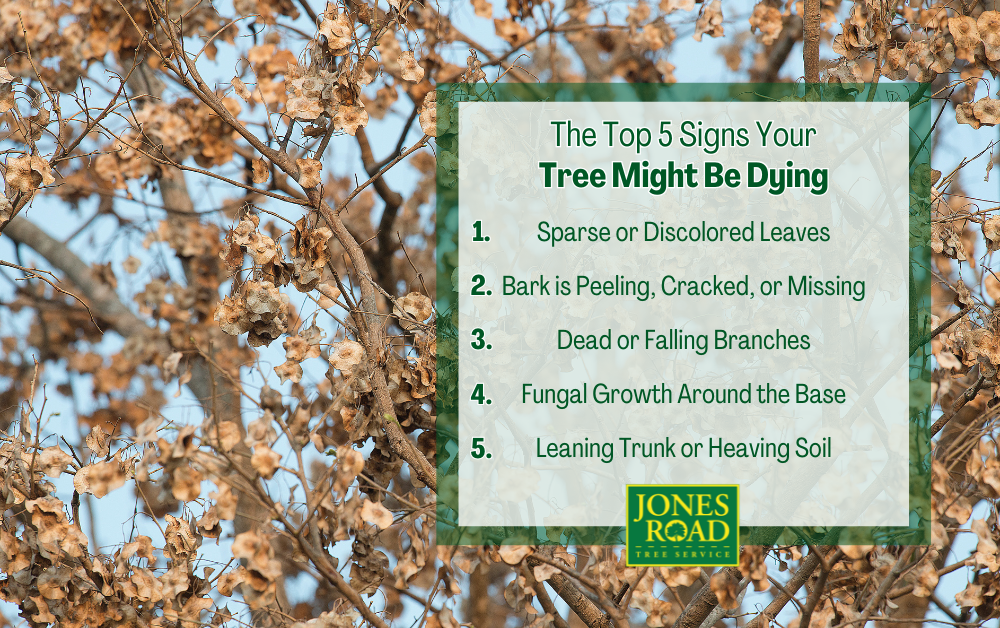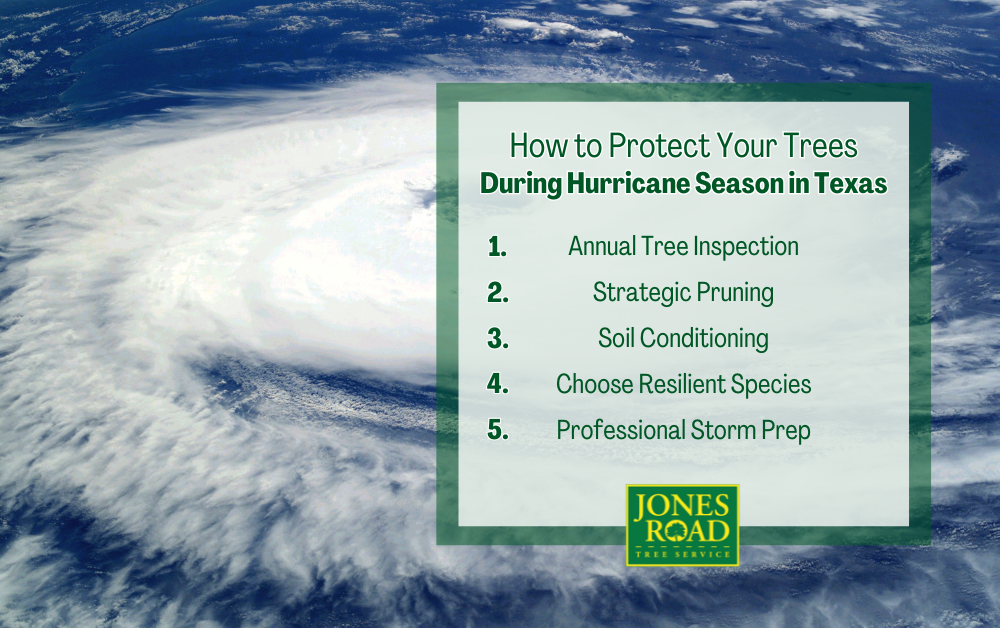Trees are one of the most valuable features on your property—they offer shade, beauty, and a natural sense of privacy—but even the strongest trees can silently decline over time. Whether due to drought, disease, pests, or root damage, a dying tree often shows subtle signs before it becomes a serious hazard. Ignoring those warning signs can lead to costly damage or even injury, especially when storms roll through. In this post, we’ll break down the top five signs your tree might be dying, so you can catch problems early and protect your home, yard, and loved ones with help from the pros at Jones Road Tree Service.
Why Trees Die: Common Causes in Texas Landscapes
Before we jump into the top five signs, it’s helpful to understand what puts trees at risk in the first place—especially in Texas.
1. Environmental Stress
Texas is notorious for unpredictable weather. Long droughts, extreme heat, sudden freezes, and high winds all take a toll on trees. Without regular care, environmental stress can weaken even healthy trees over time.
2. Soil Compaction and Root Damage
Heavy foot traffic, construction work, or even parking cars on top of root zones can compress the soil, choking off oxygen and moisture. Damaged or suffocated roots lead to instability and slow decline.
3. Pests and Disease
From oak wilt to root rot, tree pests and diseases are rampant in the South. Once infected, a tree’s health can spiral quickly if not caught early.
4. Neglect
Just like your HVAC system or roof, trees need maintenance. Skipping routine inspections, pruning, and care increases the chance of hidden problems developing.
Sign #1: Sparse or Discolored Leaves
The canopy is the crown jewel of a tree—and one of the easiest indicators of health. When a tree begins to die, the leaf coverage is usually the first place you’ll notice something off.
What to Look For:
- Thinning foliage or bare spots in the canopy
- Early leaf drop, especially in spring or summer
- Leaves that are yellowing, browning, or curling
- Uneven coloration (e.g., one side of the tree looking sickly)
In spring and summer, most healthy trees in Texas should be full and vibrant. If your tree looks sparse while others in the neighborhood are thriving, that’s a red flag.
What It Could Mean:
- Root damage is interfering with nutrient delivery
- The tree is stressed from drought or overwatering
- There could be a pest infestation or disease present
Pro Tip: Use binoculars to inspect high canopies from the ground, or contact a certified arborist to perform a full tree health evaluation.
Sign #2: Bark Is Peeling, Cracked, or Missing
Think of bark like your tree’s armor. It keeps out harmful pests, regulates moisture, and protects the living tissue underneath. When that armor starts falling apart, your tree’s health may be in jeopardy.
Warning Signs:
- Bark that peels off in large sheets
- Vertical cracks running up or down the trunk
- Areas where the bark has completely fallen off or is soft to the touch
- Sunken or discolored patches (also known as cankers)
These problems can occur due to disease, weather damage, or physical injury (like mower damage at the base). Once the bark layer is compromised, it opens the tree up to fungus, bacteria, and insects.
In particular, Texas trees like oak, ash, and pecan can become easy targets for borers and beetles once their bark is weakened.
Sign #3: Dead or Falling Branches
Tree branches can naturally shed, especially during windy weather—but if you notice branches falling more frequently or large sections dying back, your tree is sending out a distress signal.
Look for These Indicators:
- Brittle branches that snap easily
- Large dead limbs with no leaves
- Branches that have started to rot or show fungus
- A visible increase in branch drop, especially without storms
This is called dieback—when branches begin to die from the tips inward. Often, this is the result of internal decay or compromised roots. Left unaddressed, dieback can spread further into the tree, affecting the trunk and overall stability.
Why It’s Dangerous:
Dead branches pose a major risk to you, your family, and your property. Falling limbs can crush vehicles, damage roofs, or injure people below—especially during thunderstorms and strong Texas winds.
Sign #4: Fungal Growth or Mushrooms Around the Base
Mushrooms and conks (those shelf-like fungal structures) might look harmless, but they often signal internal decay or root rot—two of the most serious conditions a tree can face.
Signs to Watch For:
- Clusters of mushrooms growing at the tree’s base
- Fungal conks on the trunk or large limbs
- White, soft, or crumbly wood beneath the bark
- A strong musty or sour odor coming from the trunk
Fungi feed on dead or decaying material, meaning if they’re present, your tree may already be rotting from the inside out. Trees with compromised roots often show no symptoms above ground until they become unstable—or fall.
Sign #5: Leaning Trunk or Heaving Soil
A gentle lean can be normal in some trees—but a sudden change in angle, or signs of movement in the soil, indicate a serious structural issue.
Danger Signals:
- The tree leans more than 15 degrees
- You notice soil cracking or lifting on one side of the trunk
- Roots are exposed, and the tree appears to be tipping
- There’s a sudden lean after a storm or high winds
This kind of instability usually means root damage, decay, or failure—all of which are dangerous. A leaning tree should never be ignored, especially if it’s near your home, driveway, or power lines.
Secondary Signs Your Tree Could Be Dying
Beyond the big five, here are a few more red flags that often accompany tree decline:
- Insect infestations, such as carpenter ants, bark beetles, or borers
- Hollow or soft spots in the trunk
- Sawdust or frass (insect droppings) around the base
- Sticky sap leaking from wounds or cracks
- No new growth in spring or smaller-than-normal leaves
If your tree is showing multiple signs from this list, it’s time to take action.
Why You Shouldn’t Wait to Get a Tree Inspection
It’s easy to put off tree care until “later,” especially when things seem stable. But when it comes to dying trees, later can be too late.
Trees don’t usually fall over without warning—but the signs are subtle unless you know what to look for. A tree inspection by a professional arborist can:
- Identify hidden decay or pest infestations
- Evaluate whether your tree can be saved or needs removal
- Recommend cost-effective treatments before damage spreads
- Keep your home, family, and property safe
Can a Dying Tree Be Saved?
In many cases, yes—but time is everything.
Depending on the cause, a tree can often bounce back with:
- Deep root fertilization
- Crown thinning or corrective pruning
- Cabling or bracing weak limbs
- Pest or fungal treatments
However, if more than 50% of the canopy is dead, or there’s extensive internal rot, removal is often the safest and most cost-effective option. The only way to know for sure is to schedule a health assessment.
Why Choose Jones Road Tree Service?
At Jones Road Tree Service, we specialize in identifying and solving tree problems before they become disasters. With years of experience handling Texas trees, we know exactly what to look for and how to respond.
We offer:
- Tree health inspections
- Storm prep and emergency response
- Pruning, trimming, and structural support
- Safe, expert tree removal when needed
We don’t just cut trees—we protect what matters around them.
Worried Your Tree Might Be Dying? Let’s Take a Look.
Trees are a long-term investment—but they can become a liability when ignored. If you’ve noticed any of the signs listed above, don’t wait for the next storm to make things worse.
Contact Jones Road Tree Service today to schedule your expert tree inspection. Our trained professionals will evaluate your tree’s condition, walk you through your options, and make sure your property stays safe and beautiful.





